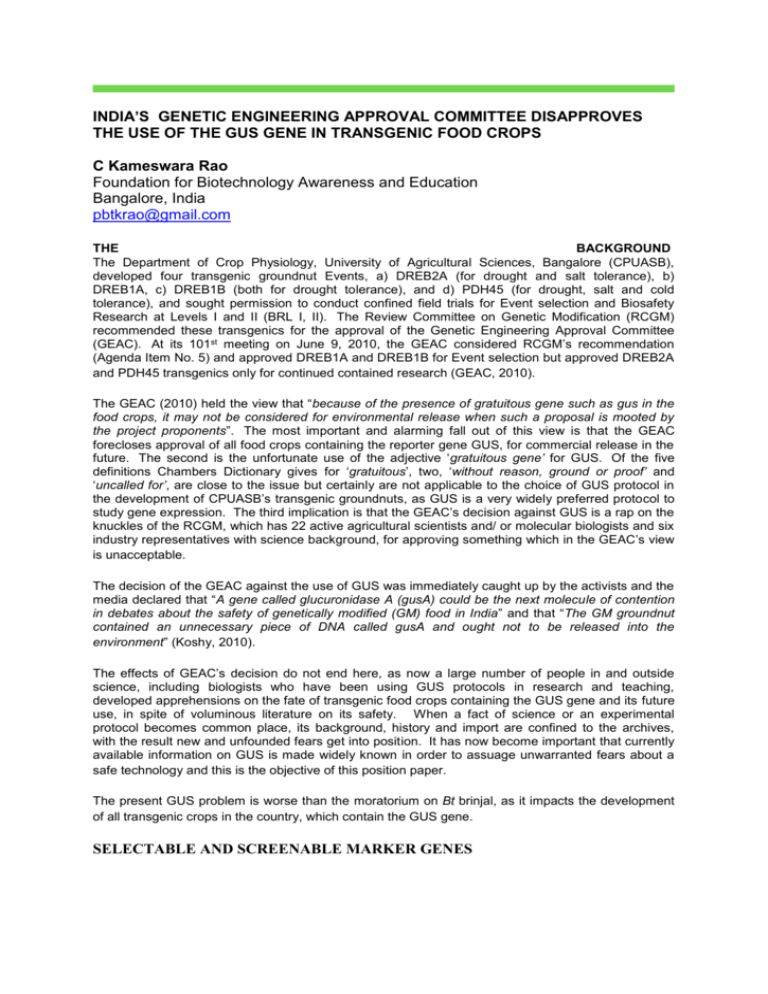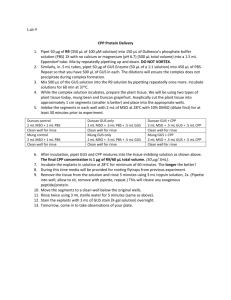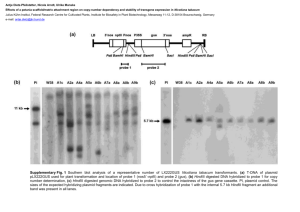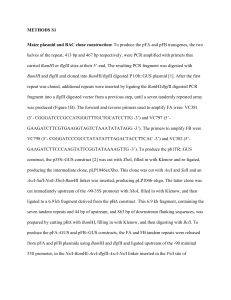GEAC disapproves GUS gene in food crops
advertisement

INDIA’S GENETIC ENGINEERING APPROVAL COMMITTEE DISAPPROVES THE USE OF THE GUS GENE IN TRANSGENIC FOOD CROPS C Kameswara Rao Foundation for Biotechnology Awareness and Education Bangalore, India pbtkrao@gmail.com THE BACKGROUND The Department of Crop Physiology, University of Agricultural Sciences, Bangalore (CPUASB), developed four transgenic groundnut Events, a) DREB2A (for drought and salt tolerance), b) DREB1A, c) DREB1B (both for drought tolerance), and d) PDH45 (for drought, salt and cold tolerance), and sought permission to conduct confined field trials for Event selection and Biosafety Research at Levels I and II (BRL I, II). The Review Committee on Genetic Modification (RCGM) recommended these transgenics for the approval of the Genetic Engineering Approval Committee (GEAC). At its 101st meeting on June 9, 2010, the GEAC considered RCGM’s recommendation (Agenda Item No. 5) and approved DREB1A and DREB1B for Event selection but approved DREB2A and PDH45 transgenics only for continued contained research (GEAC, 2010). The GEAC (2010) held the view that “because of the presence of gratuitous gene such as gus in the food crops, it may not be considered for environmental release when such a proposal is mooted by the project proponents”. The most important and alarming fall out of this view is that the GEAC forecloses approval of all food crops containing the reporter gene GUS, for commercial release in the future. The second is the unfortunate use of the adjective ‘gratuitous gene’ for GUS. Of the five definitions Chambers Dictionary gives for ‘gratuitous’, two, ‘without reason, ground or proof’ and ‘uncalled for’, are close to the issue but certainly are not applicable to the choice of GUS protocol in the development of CPUASB’s transgenic groundnuts, as GUS is a very widely preferred protocol to study gene expression. The third implication is that the GEAC’s decision against GUS is a rap on the knuckles of the RCGM, which has 22 active agricultural scientists and/ or molecular biologists and six industry representatives with science background, for approving something which in the GEAC’s view is unacceptable. The decision of the GEAC against the use of GUS was immediately caught up by the activists and the media declared that “A gene called glucuronidase A (gusA) could be the next molecule of contention in debates about the safety of genetically modified (GM) food in India” and that “The GM groundnut contained an unnecessary piece of DNA called gusA and ought not to be released into the environment” (Koshy, 2010). The effects of GEAC’s decision do not end here, as now a large number of people in and outside science, including biologists who have been using GUS protocols in research and teaching, developed apprehensions on the fate of transgenic food crops containing the GUS gene and its future use, in spite of voluminous literature on its safety. When a fact of science or an experimental protocol becomes common place, its background, history and import are confined to the archives, with the result new and unfounded fears get into position. It has now become important that currently available information on GUS is made widely known in order to assuage unwarranted fears about a safe technology and this is the objective of this position paper. The present GUS problem is worse than the moratorium on Bt brinjal, as it impacts the development of all transgenic crops in the country, which contain the GUS gene. SELECTABLE AND SCREENABLE MARKER GENES Recombinant DNA (r-DNA) protocols are used to develop improved crop varieties through genetic transformation, which involves insertion of the desired gene(s) from any source, into the nuclear or plastid genome of the recipient crop variety. The vector for genetic transformation is a composite DNA construct (gene cassette) designed to contain the desired gene(s) (transgenes) along with the required molecular machinery (such as promoters) needed for the expression of the transgenes in the new cell environment. The backbone of the gene cassette is usually the tuber inducing (Ti) plasmid (DNA) of the commonly occurring Agrobacterium tumefaciens. In order to overcome the patent problems associated with the use of Agrobacterium plasmids, Broothaerts et al.,( 2005) identified several species of bacteria outside the genus Agrobacterium, whose modified Ti plasmids can be used in genetic transformation, in the ‘open source’ platform. The gene cassette is introduced into the genome of the recipient variety using one of several methods to produce a transformed cell/tissue, from which whole transgenic plants are developed using tissue culture methods. The transgenic plants undergo rigorous evaluation, for product efficacy and biosecurity, as per each country’s mandatory regulatory regime, before commercial release. In any method of genetic transformation, only a small fraction of the treated cells become transformed. Hence, methods for the identification and selection of the transformed cells, from a vast pool of untransformed ones, are essential. This is achieved through the use of Selectable Marker genes, which are also components of the gene cassette. There are more than 50 marker genes and molecular techniques to screen for genetic transformation (Liang et al., 2010). There are two categories of markers: a) Selectable Markers and b) Screenable (scorable, reporter, visible) Markers. Marker genes are usually co-introduced into a plant genome together with the transgenes in a single plasmid (Curtis et al., 1995), but some workers used separate Effector (for genetic transformation) and Reporter (for screening) plasmids (Sakuma et al., 2006). Selectable Markers: Positive selectable marker genes promote the growth of transformed tissue. In recent strategies of positive selection, transformed cells are given the ability to grow by using a specific carbon or nitrogen source or a growth regulator as the selection agent (Liang et al., (2010). Negative selectable marker genes inhibit growth or kill the non-transformed tissue (Liang et al., 2010). In the more conventional negative selection, genes for toxic or inhibitory compounds such as antibiotic or herbicide resistance genes are used. Positive selection has been demonstrated to be successful in a variety of higher plant species, and usually provides a higher transformation frequency than negative selection. Assays for screenable markers can be destructive or nondestructive, in terms of the need to sacrifice the test material. Protocols with selectable markers have yielded 10-fold higher frequency of recovered transgenic events compared to Marker-free protocols (Birch, 1997; de Vetten et al., 2003; Darbani et al., 2007) and so the use of marker genes is preferred. Screenable Markers: Screenable (Reporter) genes encode proteins which are easily detected in a sensitive, specific, quantitative, reproducible, and rapid manner, to measure transcriptional activity and are used to investigate promoters and enhancers of gene expression and their interactions. Some commonly used reporter genes are a) Chloramphenicol acetyltransferase (CAT), a bacterial enzyme that transfers radioactive acetyl groups to chloramphenicol, b) Luciferase (LUC), a firefly enzyme that oxidizes luciferin and emits photons; c) Green fluorescent protein (GFP), an autofluorescent jellyfish protein; d) β-galactosidase (GAL), a bacterial enzyme that hydrolyzes colorless galactosides to yield colored products; and e) β-glucuronidase (GUS), an enzyme that hydrolyzes colorless glucuronides to yield insoluble colored products (Beason, 2003). GUS is the most commonly used reporter gene in plant genetic transformation studies. Identifying the small proportion of transformed cells in a large experimental cell population, using only screenable markers is tedious and time consuming. Hence, screenable markers are usually coupled with selectable markers in transformation systems as in almost all commercialized transgenic crops (Liang et al., 2010). β-GLUCURONIDASE AS A SCREENABLE MARKER Two slightly different LacZ peptides (α and Ω), both needed for activity, constitute β-galactosidase (E.C.3.2.1.23) in E. coli, which is widely used as a reporter gene in microorganisms and animals, but in plant systems its use is curtailed by the conspicuous endogenous presence of β-galactosidase (David et al., 1998; Stano et al., 2002; Esteban et al., 2005). Jefferson (1987, 1988) and Jefferson et al., (1986, 1987) demonstrated the use of the uidA (commonly referred to as the gusA or GUS), a nuclear gene of E. coli (strain K12) that encodes the enzyme β-glucuronidase (E.C. 3.2.1.31), to study gene expression in transgenic plants. Ever since, the GUS gene has been used very widely as a reporter gene in plant molecular biology and genetic engineering (Liang et al., 2010), not only in transgenic development but also in other approaches such as gene silencing (Li et al., 2008). It has been used to study gene expression in all parts of plants, including the stomata and pollen (Twell et al., 1990). With the commercial availability of staining kits, GUS is now a routine experiment to study gene expression in a very large number of training courses. That there are about 7,000 literature references to GUS is a testimony to the popularity of the use of GUS. The protocols for the localization of GUS in plant tissues have been improved providing for spectrophotometric, fluorometric, and histochemical detection (Hull and Devic, 1995; Vitha et al., 1995; Beason, 2003). Two factors are responsible for the choice of GUS in genetic transformation studies: a) The product of enzymatic cleavage of 5-bromo-4-chloro-3-indolyl glucuronide (X-GlcA) by GUS is colorless and water-soluble, and undergoes an oxidative dimerization yielding an insoluble indigo blue precipitate (Jefferson et al., 1987), which is very useful in studying gene expression in almost all situations in plants; and, b) Benzyladenine N-3-glucuronide is an inactive derivative of cytokinin, but when hydrolyzed by GUS it releases active cytokinin which stimulates regeneration of cells (Joersbo and Okkels, 1996). This activity was taken advantage of to achieve transformation frequencies that are 1.7 to 2.9-fold higher than when nptII, an antibiotic resistance gene, was used in the control. The GUSPlus gene, originally isolated from Staphylococcus sp., (RLH1), extensively altered by codon optimization for expression in plants, is a synthetic gene commercially available in several vector formats such as pCAMBIA 1305.1, 1305.2, 1105.1,1105.1R, 0105.1, 0105.1R and 0305.2, that can overcome the draw backs of the standard GUS and replace it in a variety of situations (Nguyen, 2002; Anonymous, 2010). GUSPlus was found to be functionally 10-fold superior to that of E. coli GUS (Jefferson et al., 2003). OCCURRENCE OF GUS IN NATURE The GUS gene and GUS are ubiquitous in microorganisms and animals, though nearly absent from the higher plants. Consequently, GUS DNA and GUS occur in soil and water in all environments. GUS is known from diverse taxonomic groups such as Archaea (Pyrococcus furiosus subsp. woesei; syn. Pyrococcus woesei), bacteria (E. coli, Staphylococcus sp., and Agrobacterium tumefaciens), fungi (Penicillium canescens, Scopulariopsis sp., Aspergillus nidulans and Gibberella zeae), invertebrates (Helix pomatia, the Burgandy or edible snail; Patella vulgate, the key-hole limpet) and mammals (bovine, rat, dog and human). GUS is located in the lysosomes in animals and is abundant in leucocytes, liver and serum of mammals. GUS may also be present in breast milk. In man the GUS gene is located in Chromosome 7 and in mice it is in Chromosome 5 (Birkenmeier et al., 1989). PHYSICO-CHEMICAL CHARACTERISTICS OF GUS Most characterization of GUS, a sialic acid containing glycoprotein, was done on the enzyme sourced from human, bovine and rat liver, and E. col. The GUS gene is completely sequenced with its active sites identified. There is a marked heterogeneity in the physico-chemical constitution of GUS samples from different organisms in terms of amino acid constitution and number, carbohydrate content and molecular weight (Islam et al., 1993; Shipley et al., 1993; Sakon et al., 1996; Arul et al., 2008), which is related to various mutations, with the result they are all collectively called the β-glucuronidases. Highly purified and fully characterized samples of GUS from E. coli, Helix pomatia and Patella vulgata are commercially available for research purposes. BIOLOGICAL ACTIVITY OF GUS GUS is a glycosidase that mediates the breakdown of complex carbohydrates. GUS is functional in diverse cell systems at an optimum pH 7-8. GUS activity is reversibly inhibited by various organic peroxides (Christner et al., 1970; Anonymous, 1993). GUS located in the lysosomes catalyzes hydrolysis of β-D-glucoronic acid residues in mucopolysaccharides. In the gut, brush border GUS converts conjugated bilirubrin to the unconjugated form for reabsorption. Xiong et al., (2007) demonstrated in directed evolution studies on Pyrococcus furiosus subsp. woesei (syn. Pyrococcus woesei), that the amino acids at sites 29, 213, 217, 277, 387, 491 and 496 are essential for Gus activity, among which the amino acid at site 277 was the most important as a mutation from asparagine to histidine here resulted in a 1.5-fold increase in GUS activity. The GUS from this species is thermostable as it thrives at temperatures around 100o C. RESEARCH APPLICATIONS OF GUS In clinical research human serum GUS levels reflect lysomal activity and are a diagnostic factor in the prognosis of diseases of the liver and kidneys (George, 2008) as well as in some others like leprosy (Nandan et al., 2007). GUS is also used to quantify urinary steroids. Deficiency in GUS causes the pathological ‘Sly Syndrome’ (mucopolysacchariodosis Type VII; MPS VII) resulting from an accumulation of non-hydrolyzed mucopolysaccharides (Sly et al., 1973; Birkenmeier et al., 1989), often due to the absence of the GUS gene in an individual. The widest application of GUS is its use in crop genetic engineering and was extensively used in developing transgenics and other genetic engineering protocols such as gene silencing (Li et al., 2008), as reporter gene and in studying gene expression in various situations. ADVANTAGES OF GUS ASSAYS IN CROP GENETIC ENGINEERING GUS is highly stable and tissue extracts continue to show high levels of GUS activity, even after prolonged storage. Transgenic plants expressing GUS are normal, healthy and fertile, as the enzyme does not interfere with plant function or viability. GUS activity can be measured easily and accurately using spectrophotometric, fluorometric and histochemical assays, using small amounts of transformed plant tissue (Hull and Devic, 1995). GUS is a positive selection method, as it actively favours regeneration and growth of the transgenic cells while the non-transgenic cells are starved though not killed. Higher plants tested lack intrinsic GUS activity which minimizes the chances of false positives. Although many workers use both GUS and traditional selectable marker genes for their cumulative advantages, GUS obviates the need for the latter. DISADVANTAGES OF GUS ASSAYS In GUS assays the plant tissue has to be sacrificed. A non-destructive GUS assay was used for screening large transgenic populations (Martin et al., 1992), but this has some limitations (Liang et al., 2010). PRECAUTIONS NEEDED IN GUS ASSAYS There is little or no detectable GUS activity in higher plants at pH levels used in the assay (Liang et al., 2010). However, the inclusion of methanol in the assay buffer abolishes any endogenous GUS activity (Hu et al., 1990; Kosugi et al., 1990). Leaky GUS expression in residual Agrobacterium cells may give a false GUS signal in the plant tissue as well. This is overcome by maintaining appropriate controls. There is evidence for the presence of GUS inhibitors in such plants as Arabidopsis, rice and tobacco, but correction methods for quantitative assays of transgenic and endogenous GUS have been devised (Fior and Gerola, 2009). Under certain circumstances meristem localized ectopic GUS may cause lethality in the G2-M phase of the cell cycle (Wen et al., 2004). While this might be useful in selecting for genes specifically involved in regulating the G2-M phase of the cell cycle, it is necessary to watch for GUS induced lethality, however rare it might be. Liang et al., (2010) discussed several research reports on the spatial and temporal expression patterns of GUS and technical solutions to the artifacts that GUS may throw up. Along with appropriate controls, the use second generation GUS variants such as pCAMBIA1201, 1301, 2201and 2301, and GUSPlus variants was suggested to ensure that the GUS activity detected in genetically engineered cells/tissues is derived only from GUS expressed in the plant cell. BIOSAFETY OF GUS Gilissen et al., (1998) have examined issues related to the safety of the use of GUS in transformation systems of crop plants and concluded that E. coli GUS in genetically modified crops and their products can be regarded as safe for the consumers and the environment. The human GUS gene produces large amounts of GUS and there is almost no food item we consume without the GUS gene and/or its product. The presence of the GUS gene in food and feed from genetically modified plants is unlikely to cause any harm because E. coli, the source of the GUS gene used in transgenic development, is widespread in the digestive tract of consumers and the environment. GUS activity, found in many bacterial species, is common in all tissues of vertebrates. Transgenic crops are thoroughly evaluated for over a decade to establish product efficacy and biosafety by teams of scientists prior to commercialization, and no possibilities of toxicological or adverse ecological effects of GUS have been discovered. GUS component in transgenic crops is minimal and their consumption is unlikely to add significantly to the endogenous GUS in the consumers or the environment. No enhanced outcrossing or weediness on account of the presence of GUS in the transgenics has been detected in a quarter century of research, development and commercialization of transgenic crops globally. The GUS gene in transgenics does not impart any added selective advantage to any other organism. GEAC’S DECISION AGAINST THE USE OF GUS IN TRANSGENIC CROPS The GEAC’s decision against the two GUS containing groundnut transgenics of CPUASB has no scientific basis. The GUS system was used by earlier workers with all the four genes used by the CPUASB, more particularly the transgenes DREB2A (Sakuma et al., 2006) and PDH45 (SananMishra et al., 2005), that were objected by the GEAC. There are number transgenic crops including the food crops papaya, plum, sugar beet and soybean, which contain the GUS gene, approved for commercialization in different countries (Table 1). They have not shown any adverse effects on account of the GUS gene in them. GEAC’s decision seriously impacts not just the two ground nuts, but the development of all transgenic food crops with the GUS system in India. It is now for the scientific community to put the record straight on that the use of GUS is extensive and is safe on all counts, and convince the GEAC to reconsider its position against the presence of GUS in food transgenics ACKNOWLEDGEMENT The author is grateful to a) Professor Bruce Chassy, Department of Food Science and Nutrition, College of Agriculture, Consumer and Environmental Sciences, University of Illinois, UrbanaChampaign, USA, b) Professor Wayne Parrott, Department of Crop and Soil Sciences, University of Georgia at Athens, USA, c) Professor Piero Morandini, Department of Biology, University of Milan, Italy, d) Professor G Padmanabhan, Department of Biochemistry, Indian Institute of Science, Bangalore, e) Dr P Ananda Kumar, National Research Centre for Plant Biotechnology, Indian Institute of Agricultural Research, New Delhi, and f) Dr Mittur Jagadish, Avesthagen, Bangalore, for reviewing the manuscript and for suggestions. REFERENCES Anonymous. 1993. Worthington Enzyme Manual. Worthington Biochemical Corp., Lakewood, NJ, USA. http://www.worthington-biochem.com/index/manual.html (accessed December 2, 2010). Anonymous. 2010. GUSPlus vector comparison Chart. http://www.cambia.org/daisy/cambia/3703.html. (accessed December 1, 2010). Arul, L., Benita, G. and Balasubramanian, P. 2008. Functional insight for β-glucuronidase in Escherichia coli and Staphylococcus sp., RLH1. Bioinformation, 2: 339–343. Beason, B. 2003. GUS staining of transgenic Arabidopsis. (updated March 2010). Rice University. http://www.owlnet.rice.edu/~bios311/bios311/bios413/413day5.html (accessed December 2, 2010). Birch, R.G. 1997. Plant transformation: problems and strategies for practical application. Ann. Rev. Plant Physiol. Plant Mol. Biol., 48:297–326 Birkenmeier, E.H., Davisson, M.T., Beamer, W.G., Ganschow, R.E., Vogler, C.A., Gwynn, B., Lyford, K.A., Maltais, L.M. and Wawrzyniak, C.J. 1989. Murine mucopolysaccharidosis type VII: characterization of a mouse with beta-glucoronidase deficiency. J. Clin. Invest., 83: 1258–1266. Broothaerts, W., Mitchell, H.J., Weir, B., Kaines, S., Smith, L.M., Yang, W., Mayer, J.E., RoaRodríguez, C. and Jefferson, R.A. 2005. Gene transfer to plants by diverse species of bacteria. Nature, 433: 629-633. Center for Environmental Risk Assessment. GM Crop Database. 2010. ILSIRF, Washington D.C. http://www.cera-gmc.org/?action=gm_crop_database (accessed December 7, 2010) Christner, J.E., Nand, S. and Mhatre, N.S. 1970. The reversible inhibition of β-glucuronidase by organic peroxides. Biochem. Biophys. Res. Comm., 38:1098-1104. Curtis, I.S., Power, J.B. and Davey, M.R. 1995. NPTII assays for measuring gene expression and enzyme activity in transgenic plants. Methods Mol. Biol., 49:149–159. Darbani, B., Eimanifar, A., Stewart, C.N.J. and Camargo, W.N. 2007. Methods to produce marker-free transgenic plants. Biotechnol. J., 2:83–90. David, LS., David, A.S., Kenneth, C. and Gross, A. 1998. Gene coding for tomato fruit bgalactosidase II is expressed during fruit ripening. Plant Physiol., 117:417–423. de Vetten, N., Wolters, A.M., Raemakers, K., van der Meer, I., der Stege, R., Heeres, E., Heeres, P. and Visser, R. 2003. A transformation method for obtaining marker-free plants of a cross-pollinating and vegetatively propagated crop. Nat. Biotechnol., 21:439–442. Esteban, R., Emilia, L. and Berta, D.A. 2005. Family of b-galactosidase cDNAs related to development of vegetative tissue in Cicer arietinum. Plant Sci., 168:457–466. Fior, S. and Gerola, P.D. 2009. Impact of ubiquitous inhibitors on the GUS gene reporter system: evidence from the model plants Arabidopsis, tobacco and rice and correction methods for quantitative assays of transgenic and endogenous GUS. Plant Methods, 5:19. Genetic Engineering Approval Committee. 2010. Minutes of the 101st Meeting on June 9, 2010. http://www.envfor.nic.in/divisions/csurv/geac/decision-jun-101.pdf (accessed November 30, 2010). George, J. 2008. Elevated serum β-glucuronidase reflects hepatic lysosomal fragility following toxic liver injury in rats. Biochem. Cell Biol., 86: 235–243. Gilissen, L.J., Metz, P.L., Stiekema, W.J. and Nap, J.P. 1998. Biosafety of E. coli beta-glucuronidase (GUS) in plants. Transgenic Res., 7:157-163. Hull, G. and Devic, M. 1995. The β‐glucuronidase (gus) reporter gene system (gene fusions; spectrophotometric, fluorometric and histochemical detection). In Methods in molecular biology, Vol. 49. Plant gene transfer and expression protocols. Jones, H., (ed.). Totowa, NJ, USA. pp 39–48. Hu, C., Chee, P.P., Chee, K.P.P., Chesney, R.H., Zhou, J.H., Miller, P.D. and O’brien, W.T. 1990. Intrinsic GUS-like activities in seed plants. Plant Cell Rep., 9:1–5. Islam, M.R., Grubb, J.H. and Sly, W.S. 1993. C-terminal processing of human beta-glucuronidase. The propeptide is required for full expression of catalytic activity, intracellular retention, and proper phosphorylation. J. Biol. Chem., 268: 12193–12198. Jefferson, R.A. 1987. Assaying chimeric genes in plants: The GUS gene fusion system. Plant Mol. Biol.Rep., 5: 387-405. Jefferson, R.A. 1988. Plant reporter genes: The GUS gene fusion system. In Genetic Engineering, Vol. 10, Setlow, J.K. (ed.), Plenum Publishing Corporation, New York. Pp? Jefferson, R.A., Burgess, S.M., and Hirsh, D. 1986. ß-glucuronidase from Escherichia coli as a gene fusion marker. PNAS., 83: 8447-8451. Jefferson, R A., Kavanagh, T.A., and Bevan, M.W. 1987. GUS fusions: β-glucuronidase as a sensitive and versatile gene fusion marker in higher plants. EMBO J., 6: 3901–3907. Jefferson, R.A., Harcourt, R.L., Kilian, A., Wilson, K.J. and P.K. Keese, P.K. 2003. Microbial βglucuronidase genes, gene products and uses thereof. US Patent 6: 391-547. Joersbo, M. and Okkels, F.T. 1996. A novel principle for selection of transgenic plant cells: positive selection. Plant Cell Rep., 16:219–221. Koshy, J.P. 2010. Glucuronidase—regulator rejects GM groundnut. Live Mint, July 16, 2010. http://epaper.livemint.com/ArticleText.aspx?article=16_07_2010_006_004&mode=1 (accessed November 30, 2010). Kosugi, S., Ohashi, Y., Nakajima, K., and Arai, Y. (1990) An improved assay for ß-glucuronidase in transformed cells: methanol almost completely suppresses a putative endogenous ß-glucuronidase activity. Plant Science, 70:133-140. Li, D., Behjatnia, S.A., Dry, I.B., Walker, A.R., Randles, J.W. and Rezaian, M.A. 2008. Tomato leaf curl virus satellite DNA as a gene silencing vector activated by helper virus infection. Virus Res., 8: 30-34. Liang, H., Kumar P. A., Nain, V., Powell, W. A. and Carlson, J. E. 2010. Selection and Screening Strategies. In: Transgenic Plants, Vol. 1, Principles and Development, C. Kole, C. H. Michler, A. G. Abbott and T. C. Hall (eds.), Springer, Heidelberg pp. 85-144. Martin T, Schmidt R, Altmann T, Frommer WB (1992) Non-destructive assay systems for detection of b-glucuronidase activity in higher plants. Plant Mol Biol Rep., 10:37–46. Nandan, D., Venkatesan, K., Katoch, K., and Dayal, R.S. 2007. Serum beta-glucuronidase levels in children with leprosy. Lepr. Rev., 78: 243–247. Nguyen, T.A. 2002. An improved reporter system based on a novel β-glucuronidase (GUS) from Staphylococcus sp. Ph.D., thesis, Australian National University. http://www.cambia.org/daisy/cambialabs/3707.html (accessed December 1, 2010). Shipley, J.M., Grubb, J.H. and Sly, W.S. 1993. The role of glycosylation and phosphorylation in the expression of active human β-glucuronidase. J. Biol. Chem., 268: 12193–12198. Sakon, J., Adney, W.S., Himmel, M.E., Thomas, S.R and Karplus, P.A. 1996. Crystallization and preliminary X-ray analyhsis of endoglucanase from Pyrococcus horikoshii. Biochemistry, 35: 10648– 10660. Sakuma,Y., Maruyama,K., Osakabe, Y., Qin, F., Seki, M., Shinozaki, K. and Yamaguchi-Shinozaki, K. 2006. Functional Analysis of an Arabidopsis Transcription Factor, DREB2A, Involved in Drought-Responsive Gene Expression. The Plant Cell, 18:1292–1309. Sanan-Mishra, N., Xuan Hoi Pham, X.H., Sopory, S.K. and Tuteja, N. 2005. Pea DNA helicase 45 overexpression in tobacco confers high salinity tolerance without affecting yield. PNAS, 102:509-514. Sly, W.S., Quinton, B.A., McAlister, W.H. and Rimoin, D.L. 1973. Beta glucuronidase deficiency: report of clinical, radiologic, and biochemical features of a new mucopolysaccharidosis. J. Pediatr., 82: 249–57. Stano J, Kovacs P, Miieta K, Neubert K, Tintemann H, Koreova M (2002) Localization and 1892 measurement of extracellular plant galactosidases. Acta Histochem., 104:441–444 Twell, D., Yamaguchi, J., and McCormick, S. 1990. Pollen-specific gene expression in transgenic plants: coordinate regulation of two different tomato gene promoters during microsporogenesis. Development, 109: 705–713. Vitha, S., Beneš, K., Phillips, J.P., and Gartland, K.M.A. 1995. Histochemical GUS Analysis. In Agrobacterium Protocols, K.M.A. Gartland and M.R. Davey, eds. Totowa, NJ: Humana Press. pp. 185-193. Wen, F., Woo, H-H., Hirsch, A.M. and Hawes, M.C. 2004. Lethality of Inducible, Meristem-Localized Ectopic β-Glucuronidase Expression in Plants. Plant Molecular Biology Reporter, 22: 7–14. Xiong, A.S., Peng, R.H., Zhuang, J., Li, X., Xue, Y., Liu, J.G., Gao, F., Cai, B., Chen, J.M. and Yao, Q.H. 2007. Directed evolution of a beta-galactosidase from Pyrococcus woesei resulting in increased thermostable beta-glucuronidase activity. Appl. Microbiol. Biotechnol., 77:569-78. Table 1 COMMERCIAL TRANSGENIC CROP EVENTS CARRYING E. COLI UidA (GUS) GENE Approved/deregulated events at the global level Crop Papaya Event(s) 55-1/63-1 Trait Developer Ring spot virus tolerance Cornell University Sugar GTSB77 Glyphosate tolerance Novartis, beet Monsanto Soybean G94-1, G94-19 and High oleic acid content Dupont G168 Soybean W62 and W98 Glufosinate tolerance Bayer Plum C5 Pox virus tolerance USDA Cotton 15985 (BG II) Insect tolerance Monsanto Cotton LL Cotton25 x Basta tolerance + Bayer MON15985 Insect tolerance Cotton MON15985 x Insect tolerance + Monsanto MON88913 Glyphosate tolerance Cotton MON15985-7 x Insect tolerance + Monsanto MON1445-2 Herbicide tolerance Countries USA, Canada USA, Australia, Japan, Philippines USA, Australia, Japan, Canda USA USA USA, EU, India and 10 others Japan, Korea, Mexico Australia, Colombia, South Africa and three others Australia, European region and South Korea Source: Center for Environmental Risk Assessment, ILSIRF, Washington D.C., 2010.








